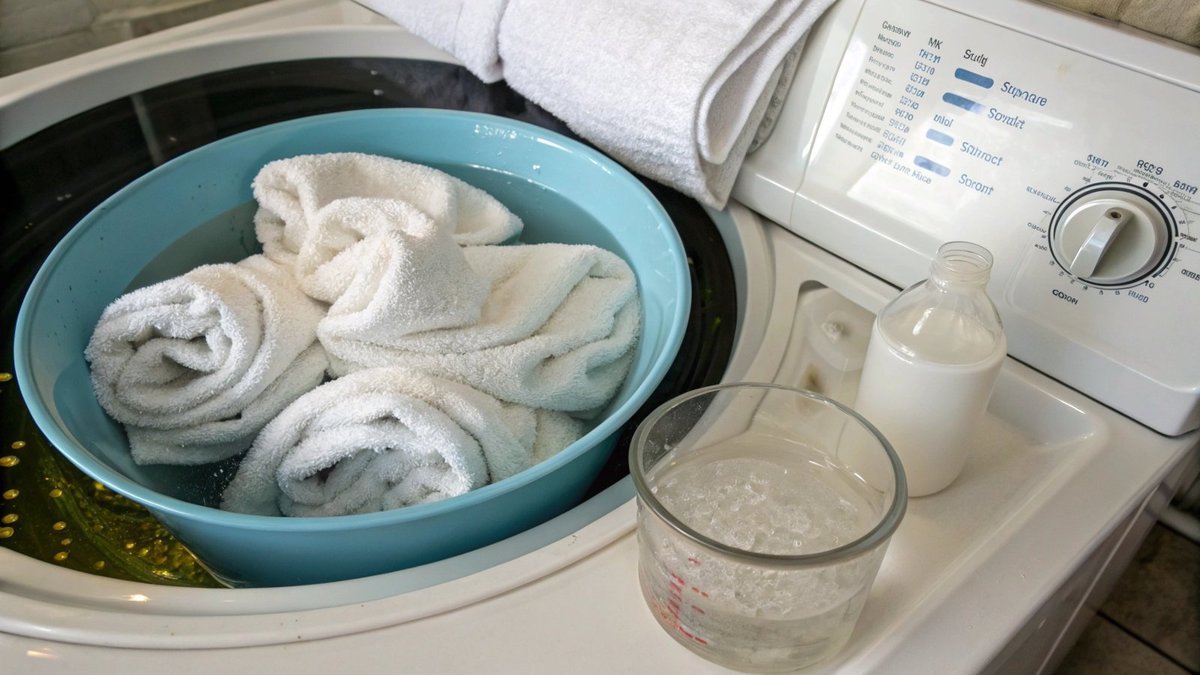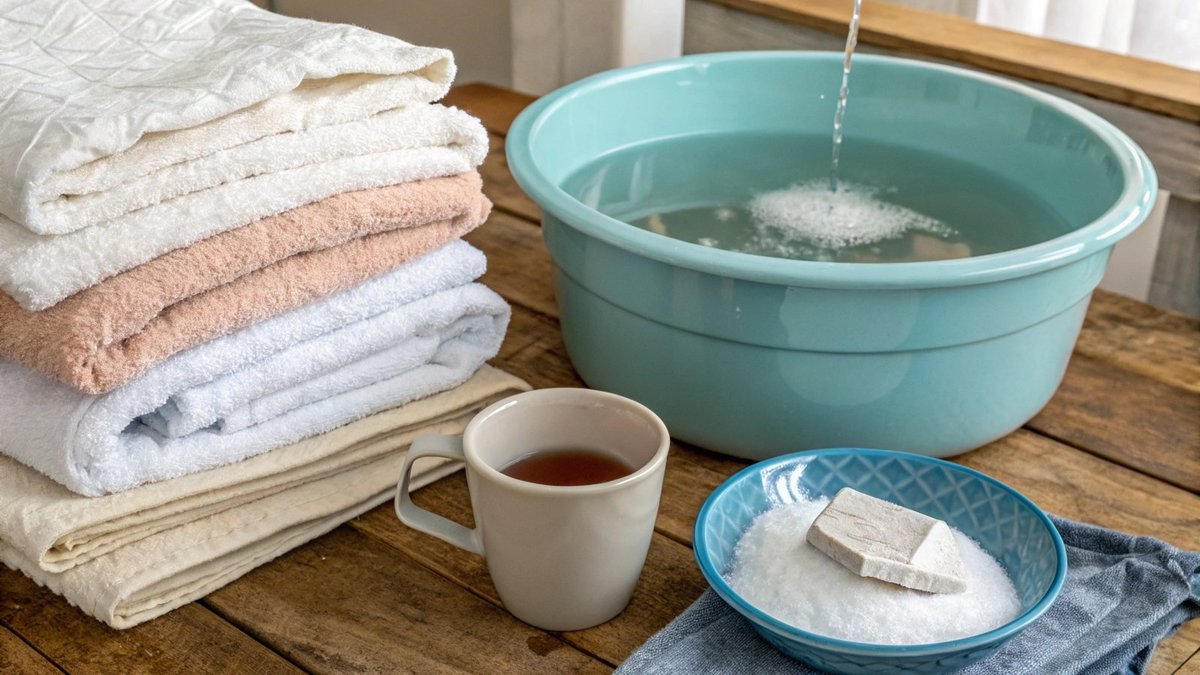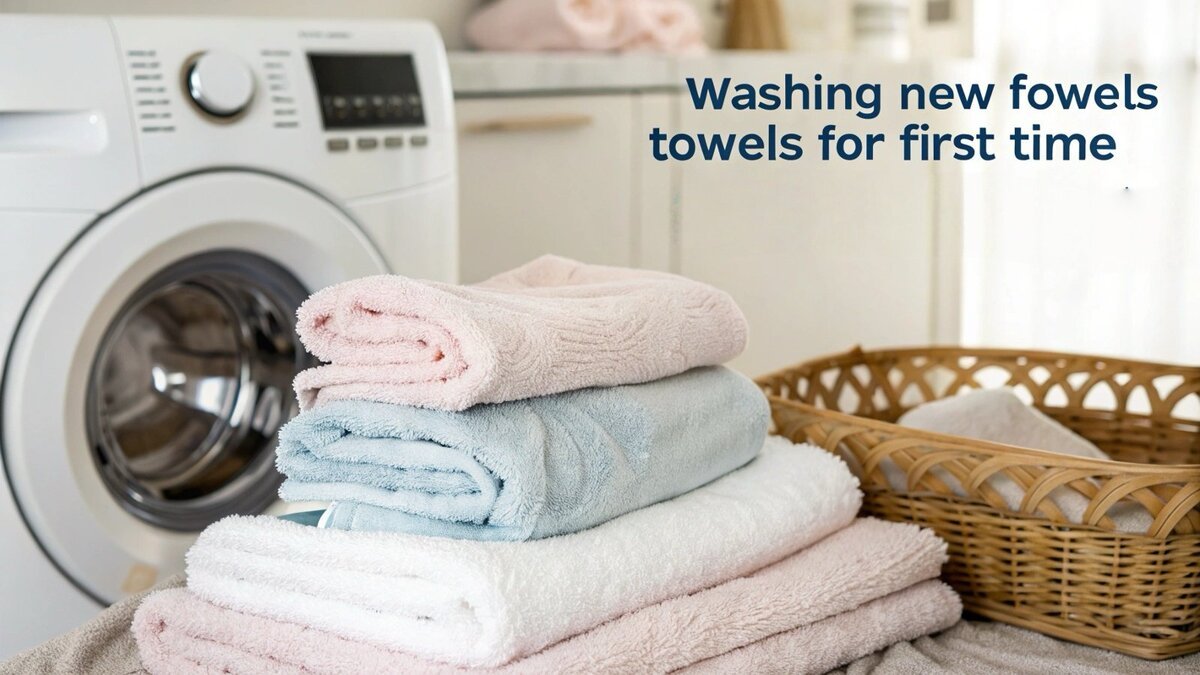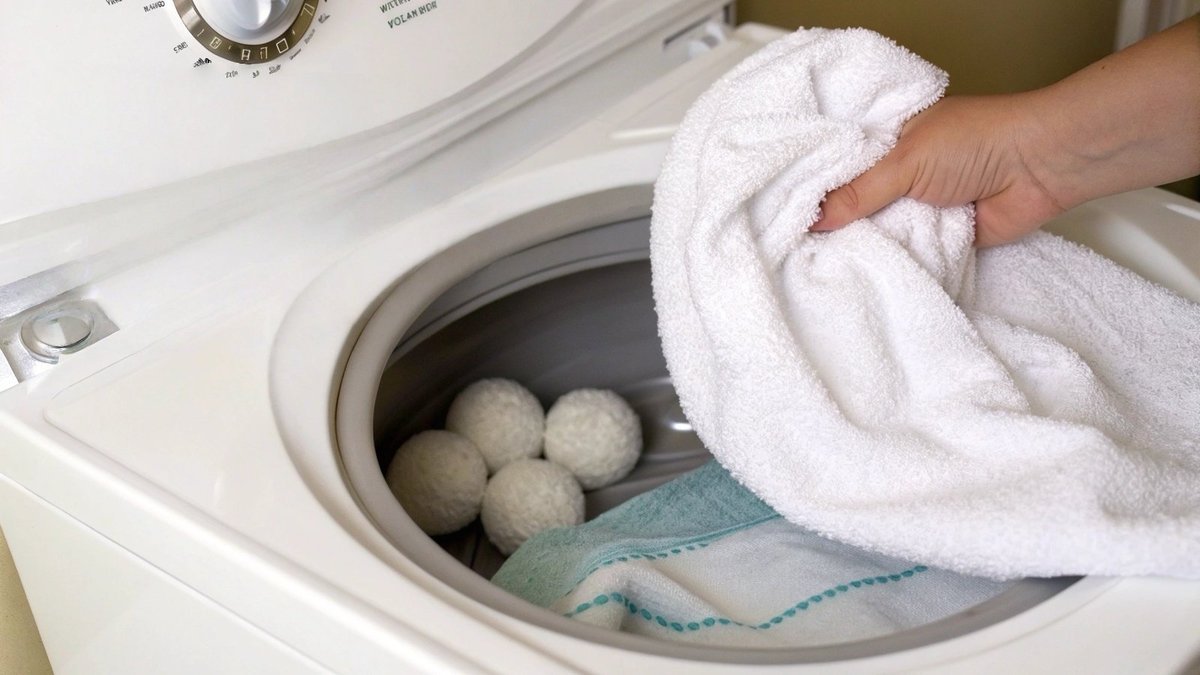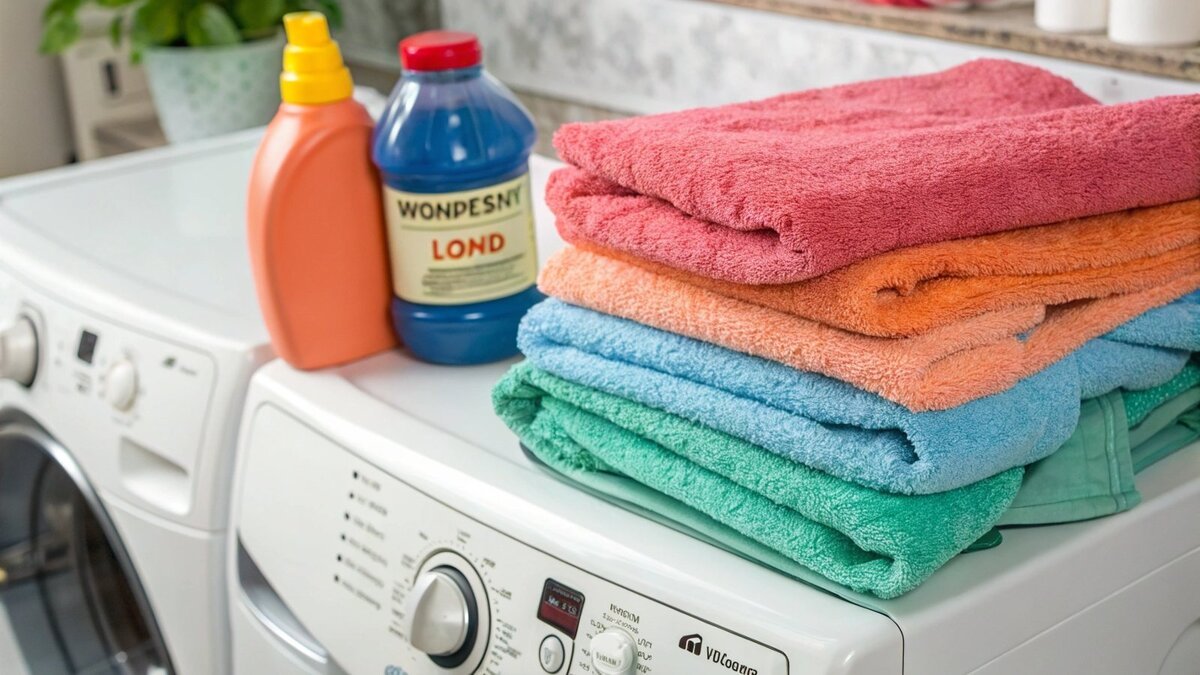Excited for your new towels but find them stiff? The wrong first wash can ruin their absorbency forever. Follow these steps to make them plush and thirsty.
Always wash new towels before use. Soak them in cold water first. Then, run a warm water wash cycle with one cup of white vinegar. Follow with a second wash cycle using a half-cup of baking soda. This process removes factory coatings and boosts absorbency.
That first wash is critical. It sets the foundation for how your towels will perform for their entire lifespan. As a towel manufacturer, I’ve seen firsthand how a simple mistake here can lead to customer disappointment. But why these specific steps? And what about water temperature or washing them with other items? Let’s break it down so you can get the best performance from your investment and keep your own customers happy. Every detail matters when you’re building a premium brand experience.
How do you wash new towels first time?
You’ve got brand-new towels, but they feel waxy. A standard wash with detergent will only make it worse. Use this specific three-step method for a perfect first wash.
First, soak new towels in cold water for an hour to open up the cotton fibers. Next, wash them in a warm cycle with one cup of white vinegar. Finally, run a second warm cycle with a half-cup of baking soda. Do not use detergent for these initial washes.
The way you wash a new towel is completely different from how you’ll wash it later. The goal isn’t to clean dirt. It’s to strip away the factory finishes. New towels are often coated with a layer of silicone or other softeners. This coating makes them look and feel great on a retail shelf but also makes them repel water. Your job is to remove that coating. I’ve had clients skip this step and immediately get complaints that their new "premium" towels don’t dry anything. This simple, detergent-free process is what we recommend to every single one of our clients to guarantee performance from day one. Breaking it down helps show why each stage is so important.
The Three-Step Process for a Perfect First Wash
| Step | Action | Purpose |
|---|---|---|
| 1. Soak | Soak new towels in cold water for 1-2 hours. | Opens up the cotton fibers gently. |
| 2. Vinegar Wash | Wash on a warm cycle with 1 cup of white vinegar. | Strips away waxy factory coatings. |
| 3. Baking Soda Wash | Run a second warm cycle with ½ cup of baking soda. | Softens the fabric and neutralizes any vinegar odor. |
This method ensures the cotton fibers are fully prepped for their true job: absorbing water.
Should you wash new towels in hot or cold water?
Hot water seems best for cleaning, right? But for new towels, hot water can set in coatings and fade colors. Use a specific temperature strategy for the best results.
For the very first wash, use a combination. Start by soaking new towels in cold water. Then, wash them on a warm water cycle, not hot. Hot water can damage delicate cotton fibers and cause shrinkage, while warm water is effective enough to help vinegar and baking soda work properly.
Choosing the right water temperature is a critical decision in textile care. For a towel’s first wash, temperature control is everything. It’s about finding the balance between being effective enough to remove residues and gentle enough to protect the brand-new fibers.
The Role of Cold Water Soaking
Starting with a cold water soak is a gentle introduction for the towel’s cotton fibers. It allows them to swell and open up without the shock of hot water, which can sometimes cause fibers to tighten up. Think of it like preparing the canvas before you start painting. This step gets the fibers ready for the main cleaning-and-stripping cycles that follow.
Why Warm Water is the Sweet Spot
Warm water is the ideal choice for the vinegar and baking soda washes. It’s effective at helping the vinegar dissolve the silicone coatings and allows the baking soda to work its softening magic. It does this without being aggressive. For our B2B clients who need to wash hundreds of towels for a new hotel or gym, we always specify warm water. It provides consistent results without risking damage to their bulk investment.
| Water Temperature | Effect on New Towels | Best Use Case |
|---|---|---|
| Cold | Gentle on fibers, good for colors. | The initial pre-soak. |
| Warm | Effectively removes residue without damage. | The main vinegar & baking soda wash cycles. |
| Hot | Can cause shrinkage, fade colors, and damage fibers. | Avoid for first washes. Use sparingly later for deep cleaning. |
How to break in a new bath towel?
New towels feel stiff and unabsorbent. Just using them won’t magically make them better. A proper break-in process unlocks the softness and thirstiness your customers expect.
Breaking in a new bath towel means removing factory finishes. This is done with the initial vinegar and baking soda washes. After washing, tumble dry them on a medium heat setting with wool dryer balls. Avoid fabric softener and dryer sheets, as they recreate a water-repellent coating.
"Breaking in" a towel is simply the process of conditioning it to reach its maximum potential for softness and absorbency. It’s not just one step, but a combination of the initial wash and the first dry. You’ve already handled the washing part, which is the most important. Now, you have to nail the drying.
The Importance of Proper Drying
How you dry the towels after their initial wash is step two of the break-in process. Proper drying fluffs up the cotton loops (also known as the "pile"). More fluff means more surface area, and more surface area means a softer feel and better absorbency.
- Use a Tumble Dryer: Air drying can leave new towels feeling stiff. A machine dryer is best for fluffing.
- Choose Medium Heat: High heat can bake the fibers, making them brittle over time. Medium heat is the sweet spot for fluffing without causing damage.
- Add Wool Dryer Balls: These are fantastic. They bounce around in the dryer, separating the towels and helping them dry faster. They also physically agitate the fibers, making the towels incredibly soft without any chemicals.
What to Avoid When Breaking In Towels
The goal is to increase absorbency. The biggest enemies to that are fabric softeners and dryer sheets. They work by coating fibers with a thin, waxy film. This film makes things feel soft but also repels water. Using them on new towels completely reverses the work you did with the vinegar wash. Avoid them entirely for towels.
Do new towels need to be washed separately?
It’s tempting to mix laundry loads to save time. But new towels can shed lint and bleed color, ruining other items. Always wash them separately for the first few cycles.
Yes, you should always wash new towels by themselves for the first 2-3 washes. New towels, especially colored ones, can release excess dye and lint. Washing them alone prevents this dye and lint from transferring onto other fabrics, protecting your other laundry items from damage and discoloration.
This is a rule I stress to all my clients, especially those in the hospitality industry. The last thing a new hotel wants is for their new, deep-blue towels to turn all their white sheets a fuzzy, blotchy blue. Doing a separate wash is a small, easy step that prevents big, costly problems. There are two main reasons this is non-negotiable.
The Problem with Lint
During manufacturing, tiny fibers can get trapped in the towel’s weave. The first few washes will dislodge these loose fibers, creating a lot of lint. This is perfectly normal. However, if you wash towels with other clothing, that lint will stick to everything. It’s particularly noticeable on dark clothes or fabrics like fleece and corduroy. Washing towels by themselves keeps this lint contained. After three washes, the amount of shedding will decrease dramatically.
Managing Color Bleeding
Even with the advanced, colorfast dyes we use at TowelTrend, it’s wise to be cautious. Deeply saturated towels, like a rich burgundy or navy, may release a small amount of excess dye during their first wash. This is called "crocking." By washing them separately, or at least with like colors, you prevent any potential color transfer. It protects your other inventory. I always tell my clients to run a "colors only" towel load for the first wash to be completely safe. This simple instruction can save them a lot of headaches later on.
Conclusion
Properly washing new towels with vinegar and baking soda—not detergent—is the key. This simple prep ensures maximum softness, absorbency, and a longer life for your textile investment.

